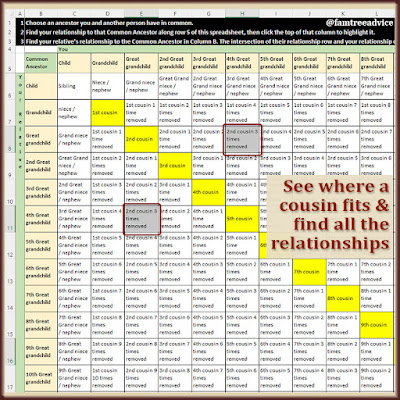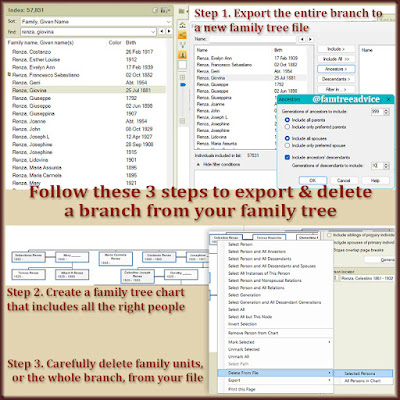It's always great when someone who writes to you about your family tree turns out to be a distant cousin. They'll usually say, "My great grandfather is in your family tree. How are we related?"
It always takes a little work before I can answer that question. First I find their ancestor in my family tree and see their relationship to me. Then I add my new cousin to my tree—without knowing the names of their parents or grandparents—to see our relationship.
That ends now. A few years ago I shared a spreadsheet I called a relationship calculator. (Download your copy.) Its main use is to help you name your exact relationship to a descendant of one of your ancestors.
For instance, when I go to Italy I visit my Dad's first cousins. Their grandparents were my great grandparents. If I want to know my relationship to my cousin's grandchild, I can use the relationship calculator. I am the great granddaughter of Francesco Iamarino, and my cousin's grandchild is his 2nd great grandchild. That makes the youngster my 2nd cousin once removed (2C1R). The spreadsheet makes that clear.
What if we look at the same spreadsheet in a different way? This time I want to find my relationship to the great grandchild of a particular cousin in my family tree.
 |
| Once you find which cell matches a particular cousin, you'll see your relationship to all their descendants. |
I'm randomly choosing Antonio Pilla from my family tree. Born in 1878, Antonio is my 2nd cousin 3 times removed (2C3R). Let's pretend his great granddaughter wrote to me asking how we're related.
Step 1 of 2. Find the Right Cell
"2nd cousin 3 times removed" is in 2 different cells of the relationship calculator:
- once in relation to my 1st great grandparent (column E row 11), and
- once in relation to my 4th great grandparent (column H row 8).
That means I need to understand how I'm related to Antonio Pilla. Our relationship chart on Ancestry.com shows a connection through my Francesco Iamarino. He's my great grandfather. That means Antonio Pilla is my 2C3R found in column E row 11 of the relationship calculator.
Step 2 of 2. Count the Generations
The rest is a snap. Antonio is my 2C3R from column E row 11, and I want to see my relationship to his great granddaughter. All I have to do is move down column E three rows:
- move down one row for Antonio's child
- move down a second row for Antonio's grandchild
- move down a third row for Antonio's great grandchild.
Now I'm at column E row 14 which reads "2nd cousin 6 times removed" (2C6R).
"No kidding, Einstein," you say. "Your 2C3R plus 3 generations equals your 2C6R."
That's right…except when it isn't. And now I finally see why that simple math works only some of the time. It depends on which side of the yellow line your relationship falls on.
The updated relationship calculator (see the link above) has a diagonal string of cells highlighted in yellow. Each yellow cell is a full-cousin relationship: 1st cousin, 2nd cousin, 3rd cousin, etc.
 |
| Same type of cousin. One to the left and one to the right of the yellow line. Which side the cousin falls on is everything! |
Antonio Pilla fell into cell E11, and that's to the left of the yellow line. But what if my relationship to him was the 2C3R found in cell H8—to the right of the yellow line? You can see that the great granddaughter of a man in cell H8 would be my 5th cousin! The progression would be:
- Antonio 2C3R
- his child 3C2R
- his grandchild 4C1R
- his great grandchild 5C
That's what's been driving me nuts. I couldn't understand why simple math didn't always work. The key is that yellow line.
Maybe you're able to figure out relationships in your head. But as you've seen, you've got to get past one big wrinkle: the yellow line.
Now I can stop putting temporary, unnamed people in my family tree just to figure out a relationship. The answer was right there all along in the relationship calculator!
For more uses of the relationship calculator:


